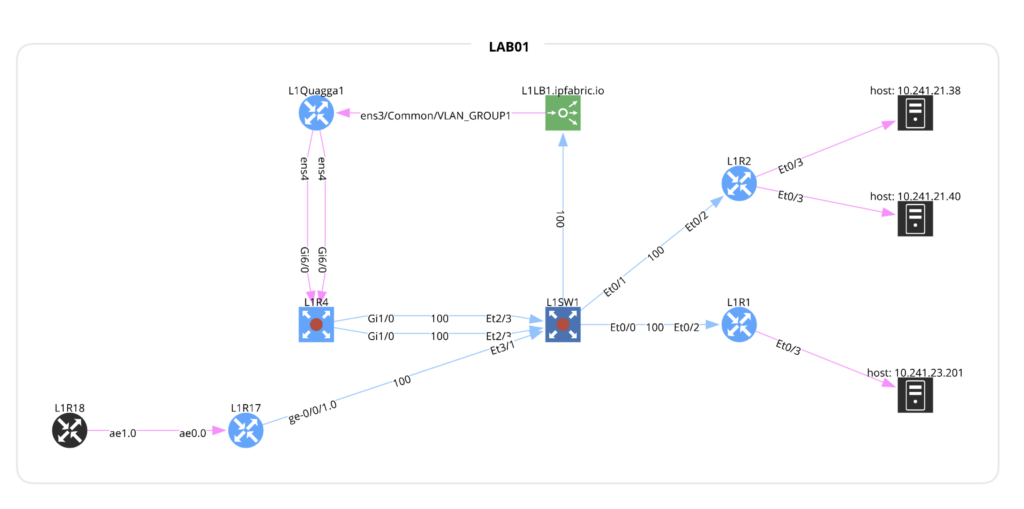

This article was co-authored with Solutions Architect Milan Zapletal
IP Fabric has expanded its support of F5 devices. This has been done to help advance network automation strategies and improve operational efficiency as F5 Networks' devices, with their extensive use in load balancing, security, and performance management, are critical components in modern network architectures.
Integrating these devices into IP Fabric for network discovery provides network engineers and administrators with a powerfully augmented toolset. This support not only simplifies network management, but also ensures network resources are handled more efficiently.
In this article, we'll delve into the specifics of how IP Fabric achieves this. We will explore the various F5 device properties that IP Fabric can now discover, such as Virtual Routing and Forwarding (VRF) instances, virtual servers, pools, nodes, F5 partitions, and Network Address Translation (NAT) rules. Moreover, we'll also discuss how IP Fabric enables users to simulate end-to-end application paths and analyze NAT rules, providing valuable insights into network performance and security.
IP Fabric's approach to discovering and managing F5 devices is deeply rooted in its use of SSH (Secure Shell), a protocol known for its robust security and versatility in network operations. By utilizing SSH, IP Fabric is able to delve into the details of F5 devices, to uncover the wealth of information essential for effective network management.
The process begins with a series of specific SSH commands, which are designed to interact with F5 devices. These commands, whilst technical in nature, are created to extract detailed information from components in the F5 infrastructure. Key amongst these being the discovery of VRF instances, which are critical for understanding the routing context and segmentation within a network.
IP Fabric effectively identifies and analyzes the configurations of virtual servers, pools, and nodes - the building blocks of F5's load balancing and application delivery capabilities.
Equally important in this discovery process are the F5 partitions and NAT rules. Partitions in F5 devices play a major role in multi-tenant environments, allowing for isolated management and application delivery contexts. NAT rules, conversely, are fundamental in directing traffic and ensuring the efficient use of IP address space. IP Fabric's ability to discover and analyze these aspects provides network administrators with a comprehensive view of their F5 deployments.
This level of detailed discovery is not just about inventory management; it's about empowering network teams with the knowledge and insights needed to make informed decisions. By understanding the exact configuration and state of F5 devices, teams can optimize performance, troubleshoot issues more effectively, and ensure a secure and efficient network environment.
Overall, integrating SSH-based discovery into IP Fabric significantly enhances how teams are able to manage their networks, as it enables a more thorough and nuanced understanding of F5 devices.
Now it's time to dive deeper into the practical implications, particularly with regards to simulating end-to-end applications paths and NAT rules.
A standout feature of IP Fabric's expanded support for F5 devices is the ability to simulate end-to-end application paths directed towards virtual servers on F5. This provides network engineers and administrators with a powerful tool to visualize and understand the journey of application data across the network. Simulating these paths allows users to effectively predict how applications will behave in the network, identify potential bottlenecks, and troubleshoot issues before they impact the end-user experience.
This simulation is particularly valuable in environments where F5 devices play a critical role in directing traffic. Virtual servers, pools, and nodes on F5 devices often form the backbone of application delivery, and understanding how traffic navigates through this infrastructure is crucial. IP Fabric's path simulation allows users to see how requests are handled by virtual servers, how they are distributed among pools and nodes, and how they are eventually delivered to end-users. Let's check out an example:

In the above image, the simulated path begins with the router L1R18 on the left hand side of the image. The destination is the virtual server in F5, which is being reached via the L3 switch L1SW1. The F5 load balancer (highlighted in green), is forwarding traffic destined for its virtual server, with the final destination nodes represented by the black servers on the right hand side of the image.
In addition to path simulation, IP Fabric's analysis of NAT rules on F5 devices is also significant. NAT rules are essential in managing how public and private IP addresses interact and are fundamental in ensuring communication remains secure and that IP space is used efficiently. IP Fabric's ability to analyze these rules helps administrators understand and manage how internal and external traffic is directed and transformed across the network.
It's important that we acknowledge the current limitations and look forward to future developments around IP Fabric and F5 devices.
Whilst IP Fabric offers extensive capabilities in discovering and simulating network paths and analyzing NAT rules, it is important to note that it currently does not support iRules analysis on F5 devices. Therefore, teams might need to use additional tools or manual analysis to understand the full scope of traffic management for F5 devices. This gap signifies an area for potential future development, however, which could provide even deeper insights and control over network traffic and application delivery.
The future is looking bright despite this current gap. As network environments continue to evolve in complexity and scale, the demand for more integrated and intelligent network management solutions will grow. IP Fabric's commitment to continuous improvement and innovation positions us well to meet these challenges.
Future updates could include more advanced analytical capabilities, deeper integration with F5's advanced features, and perhaps even support for iRules analysis. While our current F5 capabilities are impactful, the journey doesn't end here.
Want to find out more about IP Fabric? Take our free, self-guided demo for a spin. Don't forget to follow us on our LinkedIn, and on our blog, where we regularly publish new updates!
This article was co-authored with Solutions Architect Milan Zapletal
IP Fabric has expanded its support of F5 devices. This has been done to help advance network automation strategies and improve operational efficiency as F5 Networks' devices, with their extensive use in load balancing, security, and performance management, are critical components in modern network architectures.
Integrating these devices into IP Fabric for network discovery provides network engineers and administrators with a powerfully augmented toolset. This support not only simplifies network management, but also ensures network resources are handled more efficiently.
In this article, we'll delve into the specifics of how IP Fabric achieves this. We will explore the various F5 device properties that IP Fabric can now discover, such as Virtual Routing and Forwarding (VRF) instances, virtual servers, pools, nodes, F5 partitions, and Network Address Translation (NAT) rules. Moreover, we'll also discuss how IP Fabric enables users to simulate end-to-end application paths and analyze NAT rules, providing valuable insights into network performance and security.
IP Fabric's approach to discovering and managing F5 devices is deeply rooted in its use of SSH (Secure Shell), a protocol known for its robust security and versatility in network operations. By utilizing SSH, IP Fabric is able to delve into the details of F5 devices, to uncover the wealth of information essential for effective network management.
The process begins with a series of specific SSH commands, which are designed to interact with F5 devices. These commands, whilst technical in nature, are created to extract detailed information from components in the F5 infrastructure. Key amongst these being the discovery of VRF instances, which are critical for understanding the routing context and segmentation within a network.
IP Fabric effectively identifies and analyzes the configurations of virtual servers, pools, and nodes - the building blocks of F5's load balancing and application delivery capabilities.
Equally important in this discovery process are the F5 partitions and NAT rules. Partitions in F5 devices play a major role in multi-tenant environments, allowing for isolated management and application delivery contexts. NAT rules, conversely, are fundamental in directing traffic and ensuring the efficient use of IP address space. IP Fabric's ability to discover and analyze these aspects provides network administrators with a comprehensive view of their F5 deployments.
This level of detailed discovery is not just about inventory management; it's about empowering network teams with the knowledge and insights needed to make informed decisions. By understanding the exact configuration and state of F5 devices, teams can optimize performance, troubleshoot issues more effectively, and ensure a secure and efficient network environment.
Overall, integrating SSH-based discovery into IP Fabric significantly enhances how teams are able to manage their networks, as it enables a more thorough and nuanced understanding of F5 devices.
Now it's time to dive deeper into the practical implications, particularly with regards to simulating end-to-end applications paths and NAT rules.
A standout feature of IP Fabric's expanded support for F5 devices is the ability to simulate end-to-end application paths directed towards virtual servers on F5. This provides network engineers and administrators with a powerful tool to visualize and understand the journey of application data across the network. Simulating these paths allows users to effectively predict how applications will behave in the network, identify potential bottlenecks, and troubleshoot issues before they impact the end-user experience.
This simulation is particularly valuable in environments where F5 devices play a critical role in directing traffic. Virtual servers, pools, and nodes on F5 devices often form the backbone of application delivery, and understanding how traffic navigates through this infrastructure is crucial. IP Fabric's path simulation allows users to see how requests are handled by virtual servers, how they are distributed among pools and nodes, and how they are eventually delivered to end-users. Let's check out an example:

In the above image, the simulated path begins with the router L1R18 on the left hand side of the image. The destination is the virtual server in F5, which is being reached via the L3 switch L1SW1. The F5 load balancer (highlighted in green), is forwarding traffic destined for its virtual server, with the final destination nodes represented by the black servers on the right hand side of the image.
In addition to path simulation, IP Fabric's analysis of NAT rules on F5 devices is also significant. NAT rules are essential in managing how public and private IP addresses interact and are fundamental in ensuring communication remains secure and that IP space is used efficiently. IP Fabric's ability to analyze these rules helps administrators understand and manage how internal and external traffic is directed and transformed across the network.
It's important that we acknowledge the current limitations and look forward to future developments around IP Fabric and F5 devices.
Whilst IP Fabric offers extensive capabilities in discovering and simulating network paths and analyzing NAT rules, it is important to note that it currently does not support iRules analysis on F5 devices. Therefore, teams might need to use additional tools or manual analysis to understand the full scope of traffic management for F5 devices. This gap signifies an area for potential future development, however, which could provide even deeper insights and control over network traffic and application delivery.
The future is looking bright despite this current gap. As network environments continue to evolve in complexity and scale, the demand for more integrated and intelligent network management solutions will grow. IP Fabric's commitment to continuous improvement and innovation positions us well to meet these challenges.
Future updates could include more advanced analytical capabilities, deeper integration with F5's advanced features, and perhaps even support for iRules analysis. While our current F5 capabilities are impactful, the journey doesn't end here.
Want to find out more about IP Fabric? Take our free, self-guided demo for a spin. Don't forget to follow us on our LinkedIn, and on our blog, where we regularly publish new updates!




